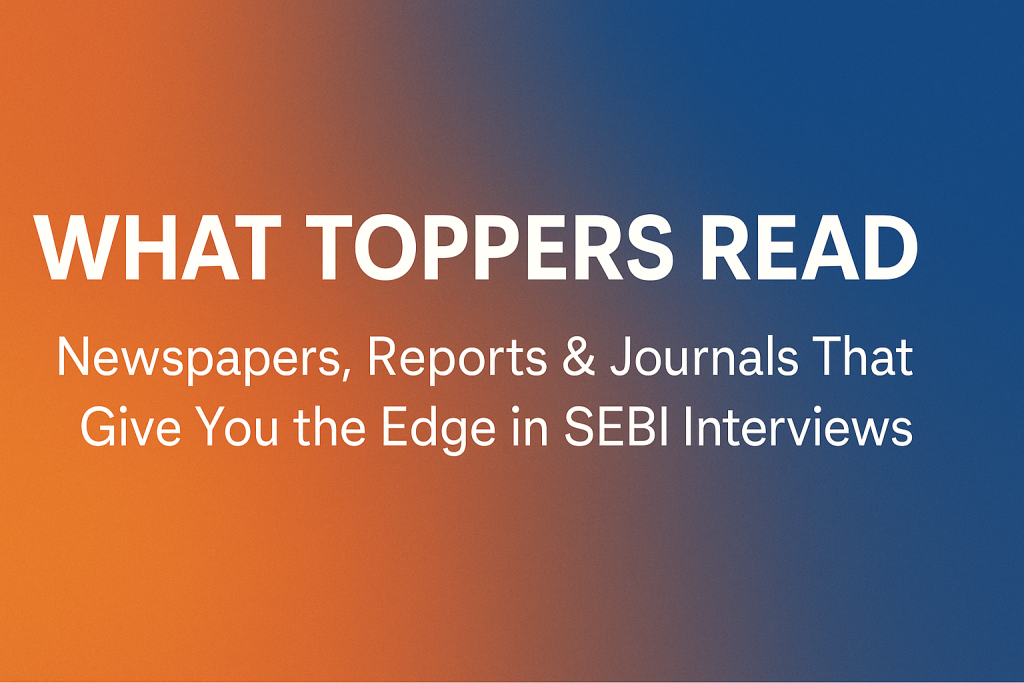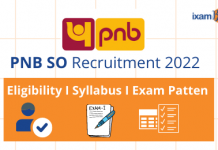Preparing for the SEBI Grade A (Assistant Manager) interview can feel like drinking from a firehose. Laws, guidelines, Section 11 powers—there’s a lot. Yet toppers swear by one deceptively simple habit: smart, regular reading. The right mix of newspapers, official SEBI documents, RBI and government reports, plus a dash of global commentary, helps them slip effortlessly from the Companies Act to the latest SEBI circular on algorithmic trading. Let’s build that same reading stack.

1. Why “Reading Smart” Beats “Reading More”
Cramming the SEBI Act is vital, but it won’t rescue you when an interviewer asks, “How have recent SEBI regulations shaped retail participation in the F&O market?” Toppers:
- Highlight the facts that link investor protection to capital-market development.
- Summarise every article in their own words—great rehearsal for viva voce.
- Connect each insight to a live policy issue—think SEBI compliance norms, or the newest SEBI market-surveillance upgrade.
Thirty intentional minutes a day trumps three frantic hours of last-minute scrolling.
2. Your Daily Indian Business Newspaper Formula
- The Hindu for Supreme Court rulings that often trigger SEBI enforcement changes.
- Business Standard for IPO pipelines, FPI flows and crisp takes on SEBI Board meetings.
- Mint for those infographics you can casually reference during the SEBI Grade A interview.
- The Economic Times for data-rich market stories—clip one statistic on, say, SEBI mutual-fund reforms each morning.
Breakfast hack: jot a 50-word précis of one story. In two weeks you’ll find your answers naturally structured, concise and keyword-rich.
3. Weekly & Monthly Must-Reads
- SEBI Bulletin – every issue packages circulars, enforcement actions and market data in one place. Read one chapter a week; your jargon will stay razor-sharp. sebi.gov.in
- RBI Bulletin – macro cues often foreshadow SEBI policy tweaks on systemic risk.
- Economic & Political Weekly (EPW) – sprinkle a peer-reviewed stat to show depth.
- Yojana or Kurukshetra – nifty for questions on financial inclusion and SEBI investor-education programmes.
- Beepedia – ixamBee released weekly and monthly bite-sized and vital news.
4. Big Reports You Simply Can’t Skip
- SEBI Annual Report 2023-24 – look for chapters on market infrastructure, surveillance upgrades and penalties secured. Memorise two enforcement anecdotes; they’re interview gold. sebi.gov.in
- Economic Survey 2024-25 – colourful charts on primary-market mobilisation and corporate-bond growth; perfect when discussing SEBI capital-market reforms.
- Union Budget & Finance Bill – any tweak to STT or capital-gains slabs lands straight in SEBI circulars within weeks.
- RBI Financial Stability Report, June 2025 – quote a stress-test number to showcase understanding of SEBI systemic-risk coordination with the RBI.
Read each once for flow, then revisit the highlighted bits before D-day.
5. Dashboards for a Ten-Minute Sunday Catch-Up
- SEBI Monthly Data Portal – grab the latest IPO size trend, or a spike in insider-trading alerts to pepper your responses.
- NSE/BSE Corporate-Action trackers – find an unusual delisting or bonus-issue example that underscores SEBI disclosure requirements.
- Business-Standard IPO Corner – use these nuggets to talk about SEBI Issue-of-Capital regulations.
One quirky data point a week often triggers the panel’s approving nod.
6. Global Reads to Broaden Your Lens
- IMF World Economic Outlook – handy for questions on capital-flow volatility and SEBI foreign-portfolio-investor (FPI) norms.
- BIS Quarterly Review – cite it when discussing CBDCs or cross-border payment rails that might shape future SEBI fintech guidelines.
- IOSCO Consultation Papers – prove you follow global best practice, not just domestic chatter.
7. Passive Learning: Podcasts & Newsletters
Turn commute time into prep time with:
- Bloomberg “Odd Lots” – macro chats translate into crisp, real-world examples for SEBI Grade A Phase II.
- CA Ajay Jain’s “Policy Pedia” (YouTube) – quick explainers of fresh SEBI circulars.
- Morning Context “Markets” newsletter – for plain-English narratives you can retell in interviews.
8. Reading in Action – A Fresh Example
A July 2025 SEBI study shows 91 per cent of retail traders in equity derivatives lost money in FY 2024-25 despite the October 2024 leverage curbs. Quote this stat while explaining why SEBI may link options leverage to cash collateral; the panel will see you’re plugged into live data, not parroting theory.
9. How a Topper Schedules Their Week (No Tables, Promise!)
Monday–Friday: skim two newspapers at breakfast, record a 50-word summary. At night, read ten pages of a major report and voice-note the takeaway—think “RBI wants better stress testing; SEBI’s market-surveillance unit likely to deepen algo-monitoring.”
Saturday: review your voice notes, craft three potential SEBI interview questions, and answer aloud.
Sunday: cruise the dashboards, pick one stat, paste it into your “Anecdote Vault”, then relax—you’ve earned it.
10. The 3-Folder Rule to Tame Overload
- Essentials – the four dailies plus SEBI Bulletin.
- Deep Dives – PDF copies of the Annual Report, Economic Survey, FSR and any SEBI consultative papers.
- Anecdote Vault – punchy stats, quirky enforcement cases, and high-impact numbers like that 91% loss figure.
Glance at Folder 3 on interview morning and you’ll sparkle with up-to-date anecdotes and SEBI keywords.
11. Interview Trap to Practise
“Retail F&O losses remain high even after the October 2024 circular. Should SEBI impose a blanket ban?”
A topper’s answer might begin:
“Sir, SEBI’s July 2025 study notes that 91 per cent of retail F&O traders still incur losses. Yet the Board favours a calibrated approach—linking options leverage to cash balances and ramping up its investor-protection and financial-literacy mandate rather than a total prohibition, keeping market depth intact.”
See how the response weaves SEBI Board policy, investor protection, market depth and factual data into one narrative? That’s the power of smart reading.
12. A 30-Day Crash Plan If Your Interview Is Looming
- Days 1–7: finish the SEBI Annual Report; extract two enforcement cases.
- Days 8–15: speed-read the Economic Survey; condense capital-market charts into one-liners.
- Days 16–20: work through the latest SEBI Bulletins; note standout circulars on buybacks or ESG disclosures.
- Days 21–25: revisit newspaper clippings; list 30 examples tagged with SEBI LODR amendments, SEBI mutual-fund risk-o-meter, etc.
- Days 26–30: mock interviews; answer every “Why” with a real-world, keyword-rich anecdote.
Trust the process—by Day 10 you’ll already feel crisper.
Closing Thoughts
Reading for a SEBI Officer Grade A interview isn’t about piling up PDFs; it’s about linking live policy, market behaviour and investor outcomes.
So brew your favourite filter coffee, open today’s e-paper, and bang out your first 50-word summary. In a few months, when the panel asks about the latest SEBI enforcement action or SEBI systemic-risk collaboration with the RBI, you’ll smile—because you’ve already read, thought, and owned the answer.
Happy reading, and see you on the other side of the interview desk!
ixamBee specializes in providing expert guidance and resources for banking exams 2025, ensuring that you are well-prepared for the Upcoming Bank Exams like RBI Grade B, NABARD Grade B, IBPS SO, and more. Our courses align with the bank exam calendar 2024, covering all the essential topics. With a focus on the upcoming bank jobs, our Previous Year Papers, BeePedia, SSC CGL, SSC CHSL, SSC MTS and other Mock Tests are designed to help you excel in upcoming banking exams.














